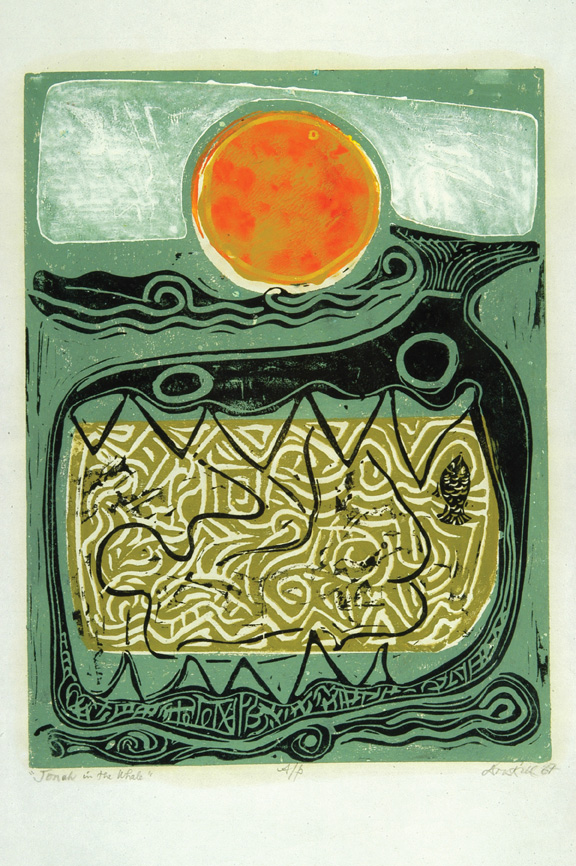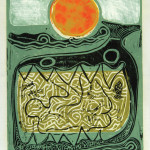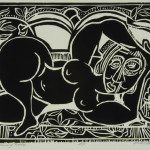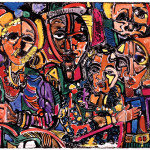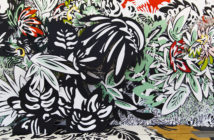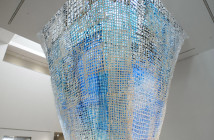The exhibition Evolution: Five Decades of Printmaking by David C. Driskell is making its last stop at the Portland Museum of Art after a two year national tour. The exhibit was organized by the David C. Driskell Center for the Study of the Visual Arts and Culture of African Americans, which is part of the University of Maryland, College Park where Driskell is Professor Emeritus. The exhibition follows the life of Driskell and his career as an artist, art historian, professor, collector, and curator. It features eighty prints and works on paper by Driskell that range from 1952-2007.
Driskell pulls his own prints and rarely prints numbered editions --- making his approach more like a painter than a typical printmaker -- pulling single prints, or monotypes. Driskell implements various techniques, including: lithography, etching, collagraphy, woodcutting, and linocutting, always saving each block he makes and often returning to it time and time again, altering the compositions and making it difficult to create a linear timeline of his work.
Driskell's ties to Maine go as far back as 1953 when he spent a summer at the Skowhegan School of Painting and Sculpture while still an undergraduate student at Howard University. He and his wife later bought a home in Falmouth, Maine and Driskell has continued his relationship with the Skowhegan School, as well as fostered connections with Maine's prestigious, private colleges.
PMA debuted the technology of a cell phone tour for this exhibition, which features Driskell's rich voice discussing ten pieces of work. Unfortunately, the tiny cell phone symbols are impossible to see against the large expanse of walls, and the maps are small, as well, causing visitors to run around the gallery, frantically trying to locate the selected works among the large gallery. Visitors are better off viewing the exhibit on their own and then listening to Driskell's explanations afterwards.
On the cell phone tour Driskell mentions that almost every exhibition venue on the tour used Spirits Watching, as their signature piece, including PMA. The exhibition catalogue also features it on its cover. This piece and other Brandywine generated pieces are very busy and represent an experimental period in Driskell's artistic career. In contrast the more traditional, classic, black and white woodcuts, or linocuts, such as Eve and the Apple II, from 1968, and the Matisse inspired Reclining Nude from 2000 stand out with their simple, classic lines. Driskell's tendency to use color so prevalently is another feature that makes him stand out as a printmaker, having gone back and colored existing work quite often in recent years. Although Driskell was using color as early as his Cubist linocut Red Table, in 1956, and the linocut and collagraph Jonah in the Whale in 1967.
The exhibit is a comprehensive representation of Driskell's body of work. The gallery space itself is large, and the artwork plentiful and almost overwhelming in its scope and breadth. But, somehow the exhibition also manages to imbue a sense of intimacy in the sense that Driskell's work is very personal. Driskell has kept visual diaries since his childhood, drawing upon these text and image-laden diaries to create his work. Not only is he inspired by his African heritage, but his childhood in the south as a son of a minister, as seen in Echoes, from 1996 that features his father's church.
The exhibit definitively showcases Driskell's versatility as a printmaker, as well as provides viewers with a history of the art of printmaking in general, as well as African culture and traditions. The exhibit includes many African sculptures and masks --- pieces from Driskell's private collection of African Art that he has acquired during his travels, and which have continued to inspire his many African heritage based pieces. The show even includes some of Driskell's blocks, which by themselves are just as beautiful as the prints. The pieces from Driskell's private art collection, and the woodblocks, as well as photos of Driskell at work in his studio add to the intimacy of the exhibition, making one feel like they personally visited Driskell's home and studio.
- David C. Driskell, Jonah in the Whale, 1967, linocut and collagraph, AP, 16 x 12 inches, collection of the artist. � David C. Driskell, 2007.
- David C. Driskell, Reclining Nude, 2000, woodcut, AP, 9 1/4 x 11 1/4 inches, collection of the artist. � David C. Driskell, 2007.
- David C. Driskell, Spirits Watching, 1986 – 1995, hand-colored offset lithograph, 23/100, Brandywine Workshop, 21 1/2 x 30 inches, collection of Tuliza Fleming. � David C. Driskell, 2007.
"Evolution: Five Decades of Printmaking by David C. Driskell" is on view October 29, 2009 - January 17, 2010 at the Portland Museum of Art.
All images are courtesy of the artist and Portland Museum of Art.

